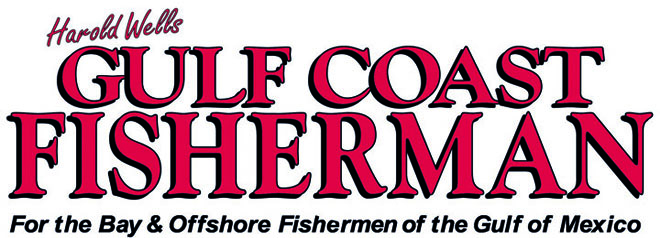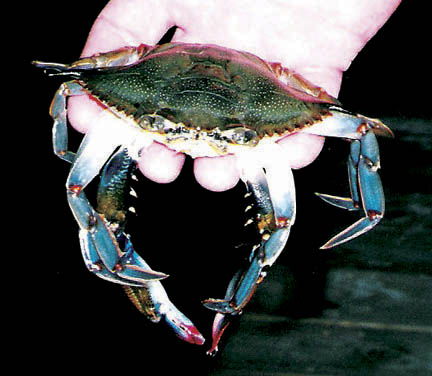
The Saltwater Magazine for Gulf Coast Fishing!
FISHING FORECASTS
| FISHING CALENDARS | ARTICLES | ADVERTISE
| SUBSCRIBE
Search Gulf Coast Fisherman's
Web Site
Past articles, specific
places or fish, etc.

Mobile Bay's Soft Shell Crabs
by Mike ThompsonSpring 2007
| CURRENT
MOON lunar phases |
It's easy to buy soft-shell crab
at the fish market.
Catching them yourself is easy if you
know the basics.

Softshell Crabs - There's not much better than a fried soft shell crab on a po-boy bun!
(Softshell Crab recipe follows at end of story)
As waters warm in early spring, coastal Alabama seafood lovers pull out the gas lanterns and scoop nets to take advantage of Mobile Bay blue crabs molting from their hard shells. At this time of year the soft shelled delicacies can be picked up and frozen, so that enjoying a soft shell Po Boy is as easy as heading to your freezer.
Living on the Gulf Coast definitely has its advantages, especially if you enjoy fishing. Most folks who enjoy fishing also enjoy the great fresh seafood available on the coast, too.
Looking at a typical seafood restaurant menu will produce an abundance of seafood items at various prices. Soft-shelled crabs normally are the highest priced item on the menu, with only shipped-in lobster being higher in price. There is a good reason for that.
In order for a blue crab to grow larger it must periodically shed its hard shell. During this molting process the crab slides out of the hard shell and for a short period is in a soft stage. If the crab is taken out of the water during this soft stage it will not harden. There is only a period of three to four hours that the crab remains in the soft stage if not taken from the water.
After the hard shell is shed, the crabs will puff up in size to 1/3 larger than in its previous hard stage.
Putting the crabs on ice also retards the hardening process. This short window of opportunity is a major factor in the high pricing of the delicacies.
CRAB COLLECTING
Fortunately for coastal Alabama residents the opportunities for picking up a few soft-shelled crabs are many. All that is needed is a light wind coupled with a low tide on Mobile Bay.
Over the years I have picked up many soft shell crabs during the warmer months. The person who introduced me to picking up soft shells was my life-long friend, Jimmy Matthews. Jimmy has probably harvested thousands of the crabs during the last forty years. When it comes to soft shell crabs, I know no one more knowledgeable on the subject.
"I've been picking up soft shell crabs as long as I can remember. Our family has always maintained a home on Mobile Bay. In the beginning it was just a summer home, but later some members lived there all year round," said Matthews. "We all loved to eat crabs, so going out at night during the warmer months looking for soft shells gave us an excuse to get out of the house."
Over the past forty years Matthews has learned a lot about how, when, and where to go to collect soft shells.
"From April through September you can be quite successful picking up soft shells on the shores of Mobile Bay. As soon as night falls you can head out with your propane lantern and some sort of container to hold the crabs. Of course you will need a net to scoop up the crabs," explained Matthews.
While walking the shores and picking up soft crabs seems simple enough, Matthews has some advice that might help you be more successful.
"It's very important to have a bright light. We use propane lanterns that can be picked up at most coastal sporting goods stores. Make sure to buy extra mantles for the lanterns as well as extra propane bottles. You will also need a way to ignite the lantern, so bring along a lighter or some matches. Another item that will come in handy is a small flashlight you can put in your pocket in case your light gets blown out," said Matthews.
Wearing an old pair of tennis shoes is a good idea. There are several things, such as rocks, rusted metal, and barnacle-covered wood to contend with while walking along at night. These shoes will provide protection from cuts or scrapes, that could spoil your night.
Having the right tools always seems to make any task easier. This is true in soft-shelling as well.
"Having a good net to scoop up the crabs is essential. The net needs to be a fine mesh net. A standard crab net just won't do. The soft shells are very limp and rubbery. The standard crab net will allow the soft crabs to slide right through the larger holes," said Matthews.
Another important tool is the container used to store the soft shells in while you continue searching the shallows. Old tried and true containers have given way to customized versions these days.
"When we were kids my mother used to send us out with tomato baskets to carry our crabs in. I have to admit they worked well, but I have come up with a more efficient way to store the crabs," said Matthews. "I found a small plastic tub like you would wash dishes in. I drilled a hole and pushed a small pull rope through the tub and tied a knot in the rope to keep it from pulling out. I attach the rope to my belt and drag it along. This leaves my hands free."
"Another benefit of the tub is that you can store a cold bottle of water, your bug spray, or an extra propane bottle in it, as long as you keep the load light," explained Matthews.
After you have gathered all your equipment you are ready to go. The best time to go is a couple of hours before low tide. In order to see the crabs you will have to find clear water. If you don't find clear water at your first location you must be ready to move to another location with better visibility.
"I have found over the years that areas with a lot of grass near the beach will be clearer. The grass acts as sort of a filter and provides better visibility," said Matthews. "You will want to work the edges of these grass beds so that you don't stir up the water making it murky."
The technique Matthews uses to locate the crabs is simple and proven. Forty years picking up soft shells on the bay has resulted in a method used over and over.
"Start at the beach and work your way out to at least fifteen feet. Be looking around all structure you find. This could be logs, rocks, depressions or any place a crab could hide. Also be on the look out for what looks like a crab with its claws pointing upwards. This is most likely a shed from a crab that has just emerged from its shell. The soft crab is usually close by. If you don't see it near the shed, move around the area at least fifteen feet. In their soft state the crabs can't move fast and you just might locate it," said Matthews.
There are other places where soft crabs like to hide that novice soft-sheller's often overlook. Mobile Bay residents really enjoy their piers. However, several recent hurricanes have destroyed these piers, leaving only the pilings left standing.
"If you come across a pier, or the pilings of an old pier, be sure to look closely around the base of the pilings. There are often washouts caused by tidal flow that soft shells use as a sanctuary till their shells harden. I have picked up a lot of crabs at these hideouts," said Matthews.
The best time to go is whenever you can. If winds are up it will put ripples on the water, which makes it hard to see. During the warmer months the winds will normally die down at night. If this is not the case it's better to try another night.
If attempted on the weekends the soft shelling folks hit the water right at dark, hoping to pick up the crabs before the competition arrives. However, according to Matthews, these groups often don't hang around long enough to get in on the best action.
I have found over the years that the best action for soft shells occurs around the full moon. It can be the two nights before the full moon or the two nights after. And just because the moon is full that doesn't mean the crabs will be popping out of their shells at dark," explained Matthews. "Sometimes the crabs won't really start shedding their shells till the moon is at its brightest. That may not occur till three in the morning. I can't tell you how many times I've loaded my tub with soft shells from three in the morning till dawn."
Both sides of Mobile Bay can produce soft shell crabs, but the western shore of the bay seems to produce more. One of the reasons may be that the western side is a little more muddy (allowing the crabs a place to burrow in and shed their shells) while the eastern shore of the bay is a little sandier. Without the benefit of the muddy holes the crabs are vulnerable to a variety of predators, besides man.
There are several places on both sides of the bay where the public can access the soft shell crabs. On the western shore you can put in on Bayfront Road, Alabama Port or at Dauphin Island. On the eastern shore you can access the bay at Mayday Park in Daphne, Fairhope Pier and Mullet Point.
If you get a chance to pick up a few soft shells crabs this season don't miss out on the opportunity. There's not much better than a fried soft shell crab on a po-boy bun!
- Jimmy Matthews Recipe for Soft Shells
- 1 cup flour, 1 cup yellow corn meal
- 1 teaspoon seafood seasoning
- 1 cup milk, 1 egg mixed, add salt & pepper.
- 12 Soft Shell Crabs, cleaned
- Peanut or vegetable oil, for frying
- Mix together flour and corn meal, plus seafood seasoning. Dredge crabs in milk and egg, and then dredge crabs in flour mixture to coat well. Shake off excess flour.
- In large fry pan or electric skillet, heat about 2 inches of cooking oil to 375 degrees. Add crabs and turn heat down to 350 degrees. Fry crabs until golden browned, about 3 minutes on each side.
- Deep fry Crabs at the same temperature and remember to turn them over after 1 to 2 minutes, fry about 3 minutes. Cooking time is depending on the size of the crab. And how crispy you want them.
- "Slap one or two between some white bread and enjoy! We call that a 'spider' sandwich."
- [ Articles | Home ]

